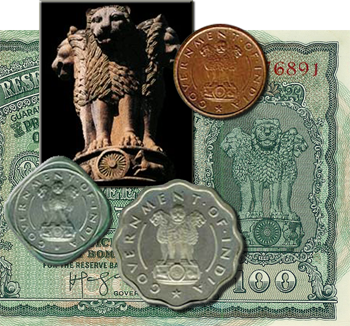|
"Making Cents"
Saturday, October 11, 2008
| M |
any countries feature a national icon on their coins and currency. The American eagle was featured on our silver coins; Canada's currency and coins featured such icons as the maple leaf, the polar bear and the voyageur; France, the fleur-de-lis; Japan, the chrysanthemum, and India, the Ashoka monument.
About six miles north of the holy Hindu city of Benares lies the village of Saranath. Here it is reputed that Buddha gave his first sermon some 2,500 years ago. Emperor Ashoka (sometimes spelled "Asoka") ordered a monument to be erected on the site of Buddha's preachings.
A 50-foot-tall sandstone column was created to hold a monument of four lions facing the four directions. They stood on a pedestal some seven feet tall atop the 50-foot sandstone column.
The monument was carved from a single slab of tan sandstone and polished by hand until it had a marble-like finish. The four lions stood on a base symbolic of the faith — the wheel of life shown four times, the sacred Brahmin cow shown twice, and the horse shown twice.
The monument stood for centuries until it toppled probably in an earthquake around the 16th Century and the top portion landed in a muddy depression where it lay undiscovered until the late 19th Century.
A team of British archaeologists exploring the area for artifacts uncovered the monument and, except for the missing face of one lion, it survived rather nicely. A small museum was erected at the site, and the seven-foot-tall lion monument was placed just inside the entry. The damaged portion faces the wall.
At independence in 1947, India adopted this as its national symbol and, since 1950, it has appeared on its coinage and currency.
A more thorough article on the monument and Indian coinage appeared in COINS magazine in August 1971. I had visited the site in 1970 and submitted the article for publication.
About six miles north of the holy Hindu city of Benares lies the village of Saranath. Here it is reputed that Buddha gave his first sermon some 2,500 years ago. Emperor Ashoka (sometimes spelled "Asoka") ordered a monument to be erected on the site of Buddha's preachings.
A 50-foot-tall sandstone column was created to hold a monument of four lions facing the four directions. They stood on a pedestal some seven feet tall atop the 50-foot sandstone column.
The monument was carved from a single slab of tan sandstone and polished by hand until it had a marble-like finish. The four lions stood on a base symbolic of the faith — the wheel of life shown four times, the sacred Brahmin cow shown twice, and the horse shown twice.
The monument stood for centuries until it toppled probably in an earthquake around the 16th Century and the top portion landed in a muddy depression where it lay undiscovered until the late 19th Century.
A team of British archaeologists exploring the area for artifacts uncovered the monument and, except for the missing face of one lion, it survived rather nicely. A small museum was erected at the site, and the seven-foot-tall lion monument was placed just inside the entry. The damaged portion faces the wall.
At independence in 1947, India adopted this as its national symbol and, since 1950, it has appeared on its coinage and currency.
A more thorough article on the monument and Indian coinage appeared in COINS magazine in August 1971. I had visited the site in 1970 and submitted the article for publication.
©2008 SCV COMMUNICATIONS GROUP & SOL TAYLOR · ALL RIGHTS RESERVED.

![[Most Recent Quotes from www.kitco.com]](http://www.kitconet.com/images/quotes_special.gif)

